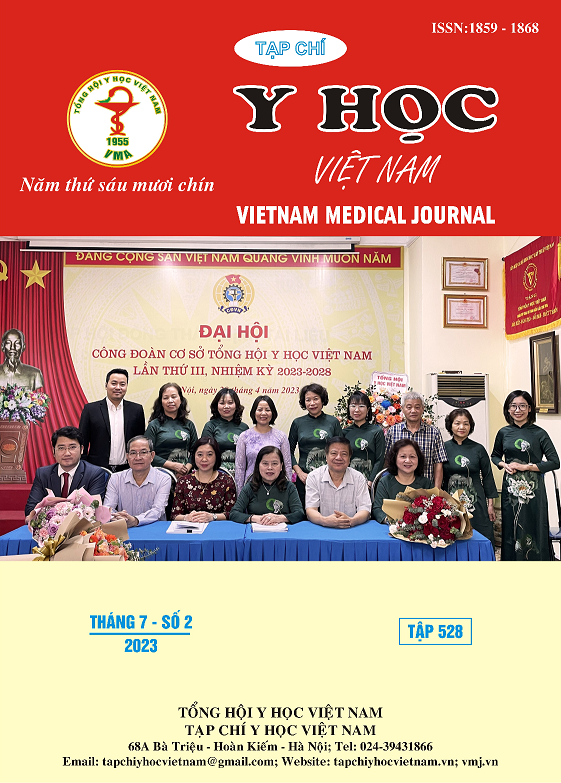REVIEW OF COLISTIN UTILISATION AT E HOSPITAL
Main Article Content
Abstract
Objectives: Evaluate the characteristics and the potential risk factors of nephrotoxicity in colistin-treated patients at E hospital. Study population and methods: A descriptive cross-sectional study was performed on 61 medical records of patients using colistin from January 2021 to December 2021 at E hospital. Results: All patients were checked for blood creatinine during the first 4-5 days of colistin administration, then the frequency rapidly dropped; by day 24, only 2% of patients received tests for creatinine. We identified 18/61 individuals (29.5%) who experienced acute nephrotoxicity as a result of colistin usage, with the degree of risk nephrotoxicity (27.8%), damage (44.4%), and renal failure (27.8%), and a median duration of nephrotoxicity of 9 days. The probability of nephrotoxicity in colistin patients increases over time. The following indicators have a statistically significant link with the probability of nephrotoxicity: age, reduced serum albumin, length of colistin therapy, and concomitant usage of furosemid. Conclusion: Nephrotoxicity is a challenge in colistin-treated patients, particularly those who are older, have a long history of colistin usage, and have concomitant diseases such as elevated blood bilirubin and reduced serum albumin. It, therefore, demonstrates the necessity for measures to prescribe medications and modify the dose correctly, customized based on renal function, in order to reduce the risk of nephrotoxicity and the efficacy of therapy for patients.
Article Details
Keywords
: colistin, nephrotoxicity, adverse drug reactions
References
2. Nation RL, Rigatto MHP, Falci DR, Zavascki AP. Polymyxin Acute Kidney Injury: Dosing and Other Strategies to Reduce Toxicity. Antibiotics. 2019;8(1):24. doi:10.3390/antibiotics8010024
3. Lopes JA, Jorge S. The RIFLE and AKIN classifications for acute kidney injury: a critical and comprehensive review. Clin Kidney J. 2013;6(1):8-14. doi:10.1093/ckj/sfs160
4. Ko H ja, Jeon M hyok, Choo E ju, et al. Early Acute Kidney Injury Is a Risk Factor That Predicts Mortality in Patients Treated with Colistin. Nephron Clin Pract. 2011;117(3):c284-c288. doi:10.1159/000320746
5. Al-Abdulkarim DA, Alzuwayed OA, Al Ammari M, Al Halwan S, Al Maklafi N, Thomas A. Colistin-induced Nephrotoxicity in a Tertiary Teaching Hospital. Saudi J Kidney Dis Transplant. 2020;31(5):1057. doi:10.4103/1319-2442.301171
6. Ozel AS, Ergönül Ö, Korten V. Colistin nephrotoxicity in critically ill patients after implementation of a new dosing strategy. J Infect Dev Ctries. 2019;13(10):877-885. doi:10.3855/ jidc.11413
7. Omrani AS, Alfahad WA, Shoukri MM, et al. High dose intravenous colistin methanesulfonate therapy is associated with high rates of nephrotoxicity; a prospective cohort study from Saudi Arabia. Ann Clin Microbiol Antimicrob. 2015;14:3. doi:10.1186/s12941-015-0062-8
8. Hải DT. Nghiên cứu độc tính thận trên bệnh nhân sử dụng colistin tại khoa hồi sức tích cực Bệnh viện Bạch Mai. Luận văn Thạc sĩ Dược học. Trường Đại học Dược Hà Nội; 2016.
9. Châu ĐTN. Khảo sát tình hình sử dụng kháng sinh colistin tại Bệnh viện Đại học Y Hà Nội. Khóa luận tốt nghiệp Dược sĩ. Trường Đại học Dược Hà Nội; 2018.
10. Hoa PTM. Khảo sát tình hình sử dụng colistin từ tháng 01 đến tháng 06 năm 2020 tại Bệnh viện nhân dân Gia Định. Khóa luận tốt nghiệp Dược sĩ. Trường Đại học Y Dược Tp. Hồ Chí Minh; 2021.


